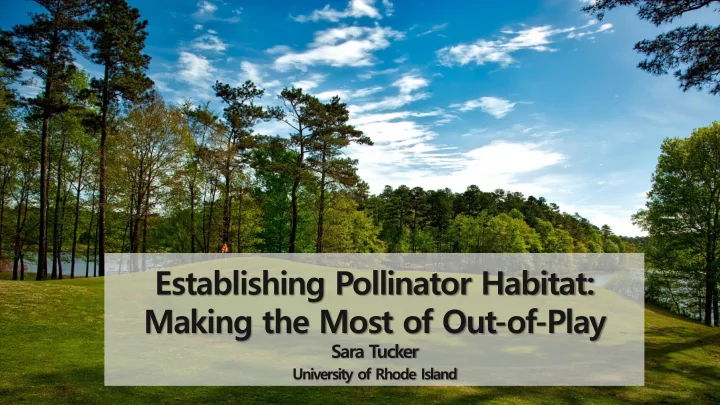

Establishing Pollinator Habitat: Making the Most of Out-of-Play Sara Tucker University of Rhode Island
Why are we talking about Pollinators?
Pollinator Decline • Pesticide exposure • Increasingly prevalent pathogens • Pest outbreaks ( Varroa ) • Habitat fragmentation • Insufficient floral resources
More Habitat = More Pollinators
Why Golf Courses?
• A variety of landscape types • Golf courses are already appreciated for naturalized beauty • Available groundskeepers and maintenance
Players and Pollinators – Is coexistence possible?
Players and Pollinators – Is coexistence possible?
Habitat = shelter + forage
Habitat = shelter + forage
How to Select Pollinator-Friendly Plants • Incorporate different plant heights, shapes, and colors • Year-round forage • Fall planting encourages most success (seed) • Broadcast seed with cat litter or sand to promote soil-seed contact • Plant species in clusters of at least 3 plants … not only does it look more natural, but allows for more efficient foraging by the pollinators
Full Sun Partial Sun Shade Dry Soil Moist Soil Dry Soil Moist Soil Dry Soil Moist Soil September-October September-October September-October September-October September-October September-October March-May Bloom June-August Bloom March-May Bloom June-August Bloom March-May Bloom June-August Bloom March-May Bloom June-August Bloom March-May Bloom June-August Bloom March-May Bloom June-August Bloom Bloom Bloom Bloom Bloom Bloom Bloom Yarrow Yarrow Yarrow Pussy willow Golden Alexander Blue Vervain Bergamot Bergamot Bergamot Cardinal flower Blue vervain Blue vervain New Jersey Tea Gray goldenrod Gray goldenrod Cardinal flower Blue vervain Blue vervain Indigo Indigo Indigo Golden Alexander Blue Vervain Butterfly milkweed New Jersey Tea Wild rose Gray goldenrod New Jersey Tea Boneset Boneset Hairy beardtongue New Jersey Tea Boneset Boneset Bergamot Hairy beardtongue Butterfly milkweed American basswood Butterfly milkweed Bergamot Gray Goldenrod Black elderberry Wild rose Cardinal flower Cardinal flower Cardinal flower Eastern Prickly Pear Butterfly milkweed Bergamot Black current Bergamot Boneset Hairy beardtongue Balsam Groundsel Cardinal flower New England Aster Bottle Gentian Bottle Gentian Virginia Wild rose Gray goldenrod Bergamot Boneset Sneezeweed Bottle Gentian Buttonbush Buttonbush mountainmint Bergamot Field thistle Cardinal flower Sneezeweed Cardinal flower New England Aster Buttonbush Jewelweed Jewelweed Wrinkleleaf Gray Goldenrod Black elderberry Cardinal flower Bottle Gentian Joepyeweed Joepyeweed Joepyeweed goldenrod White White Field thistle Partridge pea Joepyeweed Buttonbush Hooded skullcap meadowsweet meadowsweet White Partridge pea Joepyeweed Hooded skullcap Joepyeweed meadowsweet White Eastern Prickly pear Hooded skullcap Hooded skullcap meadowsweet White White meadowsweet meadowsweet Balsam groundsel
Examples of Ideal Mixes Full Sun – Dry Soil Part Sun – Moist Soil Shade – Moist Soil Bergamot Balsam Groundsel New Jersey Tea Wild Indigo Cardinal Flower Cardinal Flower Yarrow Blue Vervain Blue Vervain Partridge Pea Boneset Boneset Butterfly Milkweed New England Aster Jewelweed Field Thistle White Meadowsweet Joe-Pye Weed Gray Goldenrod Bottle Gentian White Meadowsweet Little Bluestem Little Bluestem Purple Lovegrass
Special Considerations • Dense ground cover makes it difficult to locate stray golf balls! • Consider applying a buffer strip to separate areas exposed to pesticide residues and areas of blooming pollinator plants
Maintenance Year 2: Year 1: Year 3: Sleeps Leaps! Creeps
Emphasis on weed control-- Do not mow! Year 2: Year 3: Year 1: Sleeps Leaps! Creeps
Mow 1 – 2 times, at height of no closer than 8 inches Year 2: Year 1: Year 3: Sleeps Leaps! Creeps
Minimal maintenance required – continue weed control Year 2: Year 1: Year 3: Leaps! Sleeps Creeps
Years 4+: Rehabilitation of certain areas may be required (particularly with grasses) Year 2: Year 1: Year 3: Sleeps Leaps! Creeps
Where might pollinator habitat “fit”?
Around clubhouses
At the edge of wooded spaces
Around ponds
Where to Source Pollinator Plants • Blue Moon Farm Perennials: bluemoonfarmperennials.com/ • New England Wildflower Society: www.newfs.org/ • Rhody Native: rinhs.org/who-we-are-what-we-do/programs- projects/rhody-native-home/
Resources for More Information
Acknowledgements • Produced with support from Dr. Noel Jackson Research Fellowship • Adapted from presentations by Kelly Gill (Xerces Society) and Gary Casabona (Natural Resources Conservation Service) • Many thanks to Gary Casabona for technical advice • Many thanks to Hope Leeson for her review of the final plant list Sara Tucker Sara_Tucker@uri.edu
Recommend
More recommend